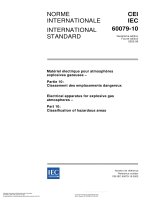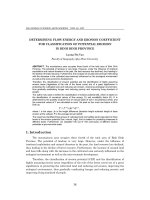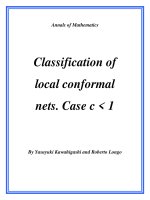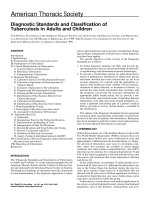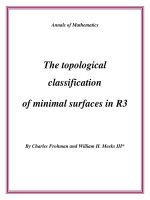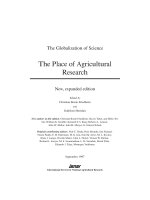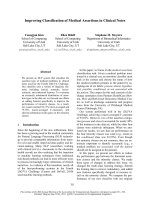034 classification of sounds voice place manner
Bạn đang xem bản rút gọn của tài liệu. Xem và tải ngay bản đầy đủ của tài liệu tại đây (221.45 KB, 3 trang )
Prof. Francisco Zabala - 2016
1
CLASSIFICATION OF SOUNDS IN DETAIL
A thorough description of a speech sound needs more than three epithets (i.e. voicing, place and manner of articulation). The
following guide focuses on the decisive and salient choices that constitute a consonantal sound:
1.
What organs are used to set the airstream in motion?
In normal speech, all English and Spanish sounds are PULMONIC. It is the diaphragm that compresses the lungs so that the air
contained in them is pushed out.
2. What direction does the airstream take?
In English and Spanish, the airstream is pushed outwards, so the sounds are EGRESSIVE.
3. How do the vocal folds work?
a. The vocal folds may be set in motion by the airstream that passes through them. The air-pressure is built up
behind the closed vocal folds till it forces them to open; when the pressure is released, the flaps come together
again. This process, which is repeated hundreds of times per second, is called PHONATION or VOICING.
b. The glottis may be held wide open (i.e. the vocal folds are not in contact) so that the airstream passes freely
through them without vibration. There is no phonation, so this is the position the vocal folds take for the
production of VOICELESS sounds.
c. The vocal folds may be held firmly together so that the air coming from the lungs is held below them. This is
the position the vocal folds take for the production of the GLOTTAL STOP Z>\.
4. What position does the velum take?
a. If the velum is raised, then the nasal resonator is shut off. The airstream is forced to escape through the
mouth. These sounds are ORAL.
b. If the velum is lowered, then the nasal resonator is open. If there is a complete obstruction to the
airstream in the mouth, the air will escape through the nose. These sounds are NASAL.
c. If the velum is lowered, then the nasal resonator is open. If the airstream can escape through the mouth
and nose at the same time, the resulting sounds are NASALIZED.
2
Prof. Francisco Zabala - 2016
5. What articulators are at play?
The articulators that intervene the most in the production of a sound determine its PLACE OF ARTICULATION. The articulators that
are movable are considered to be ACTIVE, while the ones that cannot move are called PASSIVE.
Label
Passive articulator
Active articulator
1. Bilabial
----
both lips
2. Labiodental
upper front teeth
lower lip
3. Dental
upper front teeth
tongue tip
4. Alveolar
alveolar ridge
5. Postalveolar
6. Palatoalveolar
7. Palatal
8. Velar
9. Glottal
rear of the alveolar ridge
front of the hard palate
hard palate
soft palate/velum
----
Examples
.o+
a+
l+
v.
.e+
u.
.S+
C.
tongue tip
.s+
c+
m+
k+
r+
y.
tongue tip
blade/front of the tongue
front of the tongue
back of the tongue
vocal folds
.q.
.R+
Y+
sR+
cY.
.i.
.j+
f+
M+
v.
.g.
Z>\
3
Prof. Francisco Zabala - 2016
6. How do the articulators interact?
The behaviour of the articulators determines the MANNER OF ARTICULATION.
a. A PLOSIVE consonant shows an articulation of complete oral closure. It’s made up of three stages: (1) a closing stage, where
the active articulator approaches a passive articulator (or where both active articulators move towards each other), thus
blocking the air passage; (2) a compression stage, where the airstream coming from the lungs builds up pressure behind the
oral closure; and (3) the release stage, in which the abrupt separation of the articulators lets the pent up air escape with a
burst noise called plosion.
Articulator
airstream
Articulator
Closing
stage
Compression
stage
Abrupt release
stage
b. A FRICATIVE consonant consists of an articulation of narrow stricture that produces turbulence as the air coming from the
lungs fights its way out of the oral cavity. The active articulator comes close to the passive articulator and forms a narrow
channel.
Articulator
airstream
Articulator
c. An AFFRICATE consonant is a unit that made up of two elements: an initial plosive element and a fricative second element. It
consists of three stages: (1) a closing stage, (2) a compression stage, and (3) a slow fricative release stage. It’s this last one
that differentiates an affricate from a plosive. The release is not abrupt this time: the organs separate so as to let the
compressed air out, but they are quite close to each other so that this narrow passage forces the airstream to cause friction.
Articulator
airstream
Articulator
Closing
stage
Compression
stage
Slow fricative release
stage
d. An APPROXIMANT sound consists of the two articulators coming towards each other, but they are not close enough to produce
friction. The air escapes freely through this wide stricture.
Articulator
airstream
Articulator
e. For the production of a nasal consonant the velum is lowered so that the passage to the nasal cavity is open.
Two articulators come in contact in the oral cavity and block it so that the air that can’t escape through the
mouth is forced out through the nasal cavity.
